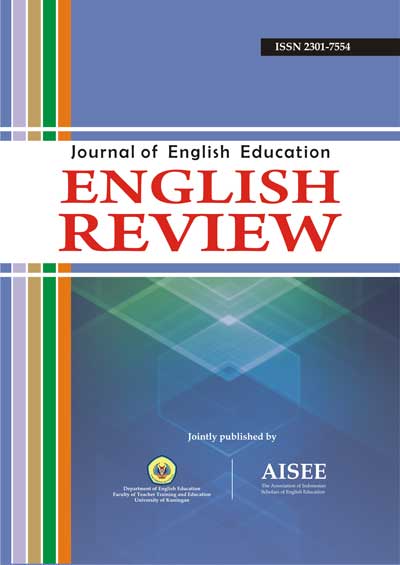IMPROVING THE QUALITY OF LANGUAGE CENTRES IN SALATIGA THROUGH GOOD RECRUITMENT PROCESS AND TEACHING EFFECTIVENESS STANDARD
Abstract
Abstract: The focus of this study is improving the quality of recruitment and teaching standards at three language centres in Salatiga. The purposes of this study are helping the managers of language centres in Salatiga to ï¬nd an appropriate way to recruit new teachers and helping teachers to be more effective in teaching. This research is qualitative descriptive interpretive and quantitative with a simple calculation. The data were collected by means of interview, questionnaire, and observation. The researcher suggests that researches on other samples and population on similar area need to be done so that the development of knowledge will improve sustainably. It was also found the fact that all teachers were not really up to date with the latest research, articles, journals, and books in terms of language teaching and teacher education. They should be encouraged to be more independent in searching for sources containing current teaching materials.
Keywords: quality, language centres, recruitment process, teaching effectiveness standard
References
Brandt, C. (2007). Giving reflection a voice: a strategy for self-evaluation and assessment in TESOL teacher preparation. In C. Coombe, M. Al-Hamly, P. Davidson & S. Troudi (Eds.), Evaluating Teacher Effectiveness in ESL/EFL Contexts. 199-212. Michigan: University of Michigan.
Braskamp, L., Brandenburg, D., & Ory, j. (1984). Evaluating teaching effectiveness. Washington D. C. : SAGE Publications.
Brown, D. (2001). Teaching by principles: An interactive approach to language pedagogy. New York: Pearson Education.
Day, R. (1990). Teacher observation in secong language teacher education. In Richards & Nunan (Eds), Second language teacher education. 43-61. Cambridge: Cambridge University Press.
Doyle, T. (2002). Evaluating teacher effectiveness – Research summary. Retrieved October 3rd 2010. http://www.tqsource.org/publications/teacherEffectiveness.php.
Eken, D. (2007). An exploration of teaching effectiveness: an attempt to define the less easily definable. In C. Coombe, M. Al-Hamly, P. Davidson & S. Troudi (Eds.), Evaluating Teacher Effectiveness in ESL/EFL Contexts. 167-182. Michigan: University of Michigan.
Goe, L., Bell, C., & Little, O. (2008). Approaches to evaluating teacher effectiveness: A research synthesis. Retrieved October 3rd 2010. File:///F:/EvalTeachEffec.htm.
Imron, A. (2007). Correlation of communication effectiveness with teachers’ performance. Retrieved October 3 rd 2010. http://www.docstoc.com.
Jihad, A & Haris, A. (2010). Evaluasi pembelajaran. Yogyakarta: Multi Pressindo.
Kaufman, D. (2007). A multidisciplinary approach to assessment in teacher education. In C. Coombe, M. Al-Hamly, P. Davidson & S. Troudi (Eds.), Evaluating Teacher Effectiveness in ESL/EFL Contexts. 43-56. Michigan: University of Michigan.
Kyriacou, C. (1986). Effective teaching in schools. Padstow: T J Press Ltd.
Richards, J. & Schmidt, R. (2002). Longman dictionary of language teaching and applied linguistics. Third Edition. London: Pearson Educated Limited.
Marno & Idris, M. (2010). Strategi & metode pengajaran: Menciptakan ketrampilan mengajar yang efektif dan edukatif. Yogyakarta: Ar-Ruzz Media.
McCloskey, M., Thornton, B., & Touba, N. (2007). New standards for a new era: Developing tools to assess the qualified teacher. In C. Coombe, M. Al-Hamly, P. Davidson & S. Troudi (Eds.), Evaluating Teacher Effectiveness in ESL/EFL Contexts. 7-24. Michigan: University of Michigan.
Miller, L., & Young, J. (2007). What’s in It for Me? A Performance Management System to Please Everyone. In C. Coombe, M. Al-Hamly, P. Davidson & S. Troudi (Eds.), Evaluating Teacher Effectiveness in ESL/EFL Contexts. 74-88. Michigan: University of Michigan.
Nunan, D. (1990). Action research in the language classroom In Richards & Nunan (Eds), Second language teacher education. 62-81. Cambridge: Cambridge University Press.
Richards, J. (1990). The dilemma of teacher education in second language teaching. In Richards & Nunan (Eds), Second language teacher education. 3-15. Cambridge: Cambridge University Press.
Stoynoff, S. (2007). Building a Context-Specific Teacher Evaluation System for an ESL Program. In C. Coombe, M. Al-Hamly, P. Davidson & S. Troudi (Eds.), Evaluating Teacher Effectiveness in ESL/EFL Contexts. 106-118. Michigan: University of Michigan.
Strauss, A. & Corbin, J. (1990). Basics of qualitative research. Washington D. C.: SAGE Publications.
Sugiyono. (2007). Metode penelitian pendidikan: Pendekatan kuantitatif, kualitatif, dan R&D. Bandung: ALFABETA
Tayibnapis, F. (2008). Evaluasi program dan instrumen evaluasi untuk program pendidikan dan penelitian. Jakarta: Rineka Cipta.
All articles published in English Review: Journal of English Education (ERJEE) are licensed under the Creative Commons Attribution 4.0 International License (CC BY 4.0).
Copyright Ownership
Authors retain the copyright of their articles and grant ERJEE the right of first publication. The journal is granted a non-exclusive license to publish, reproduce, and distribute the article in any format, medium, or platform, provided that proper credit is given to the original authors.
License Terms – CC BY 4.0
Under the Creative Commons Attribution 4.0 International License, others are free to:
- Share — copy and redistribute the material in any medium or format
- Adapt — remix, transform, and build upon the material for any purpose, even commercially
As long as they:
- Provide appropriate credit to the original author(s) and source
- Provide a link to the license (https://creativecommons.org/licenses/by/4.0/)
- Indicate if any changes were made
There are no restrictions on the reuse, reproduction, or adaptation of published articles as long as attribution is properly given.
Author Warranties
By submitting a manuscript to ERJEE, authors confirm that:
- The work is original and does not infringe any existing copyright.
- The manuscript has not been previously published and is not under consideration elsewhere.
- All sources and references are appropriately acknowledged.
- Necessary permissions have been obtained for any copyrighted materials used.










